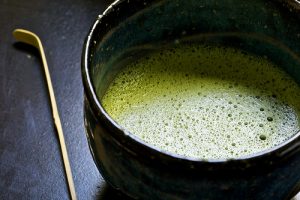
One of the attractive things about preparing matcha is its characteristic layer of foam.
Did you know that foaming in matcha is possible thanks to saponin?
What is saponin?
At the chemical level, saponins are compounds that have a glycoside (a sugar bound to a small organic molecule) functional group and a triterpene (organic molecule with formula C30H48) derivative.
Saponins are found in many plants, and there are many different types of saponins. The name comes from the soapwort plant (Saponaria), because its root was used as a soap. The reason for this is that saponin is a natural foaming agent and a detergent. In addition, it also has antimicrobial and antifungal properties.
Saponin is found in all legumes, such as soy beans, peas and lentils. Other examples of foods containing saponin are bean sprouts, leeks, onions, quinoa, asparagus, beets and even red wine. Regarding taste, saponin is bitter and astringent.
In tea leaves, you’ll find a saponin content of 0.1% and it’s best ingested by consuming the whole leaves, as is the case with matcha and funmatsucha.
Health benefits of saponin
Although not as popular as EGCG, saponin is also a beneficial component in green tea. The most important health benefit is that it lowers the absorption of cholesterol. It does this by binding to cholesterol and bile acids in the intestinal tract.
Saponin is also an anti-inflammatory agent, an expectorant, and an antioxidant (but not as potent as EGCG). You’ll be surprised to find out that the health benefits of ginseng (a plant used as a medicinal herb) are mainly due to its saponin content.
Tea leaves aren’t a good source of it, so I wouldn’t recommend drinking green tea for its saponin content only. It’s just a good addition to the overall benefits of green tea.
In Japan you’ll find a tea meant exclusively for saponin intake. Click here to read the article.
P.S. If you liked this article, join the newsletter! You’ll be notified as soon as I publish, and you’ll also get info about future projects and other news.
Sources:
Quantitative Analysis of Saponins in a Tea-Leaf Extract and their Antihypercholesterolemic Activity
Effects of pH on antioxidant and antimicrobial properties of tea saponins; Yan Li,
Yumin Du, Chang Zou; European Food Research and Technology; 2009, Vol 228, Issue 6, pp 1023-1028
Effect of Alfalfa Saponins on Intestinal Cholesterol Absorption in Rats
Antioxidant Effect of Saponin: Potential Action of a Soybean Flavonoid on Glucose Tolerance and Risk Factors for Atherosclerosis; Rodrigues HG, Diniz YS, Faine LA, Galhardi CM, Burneiko RC, Almeida JA, Ribas BO, Novelli EL; International journal of food sciences and nutrition; 2005; 56(2): 79-85.





November 20, 2013
very interesting.